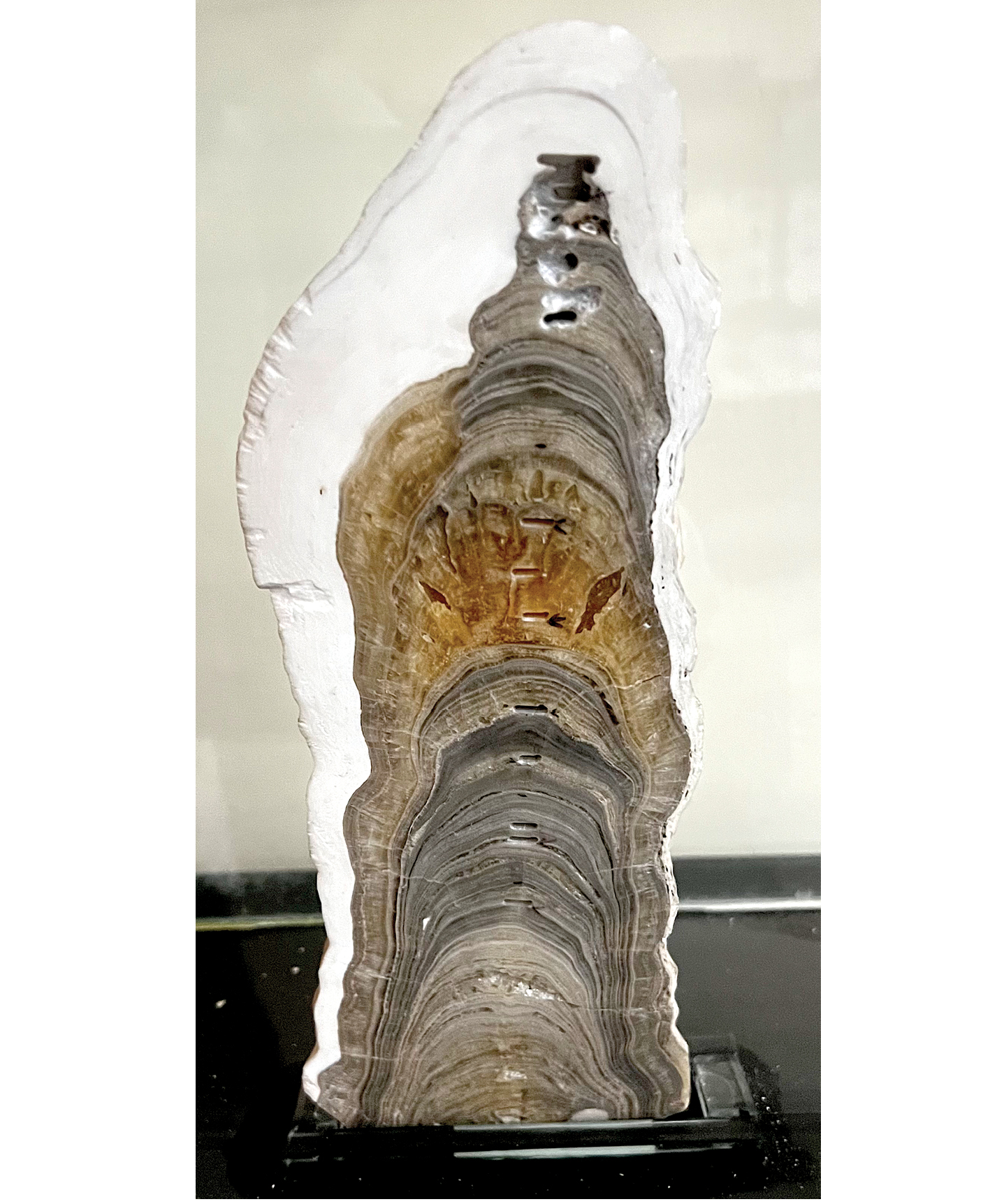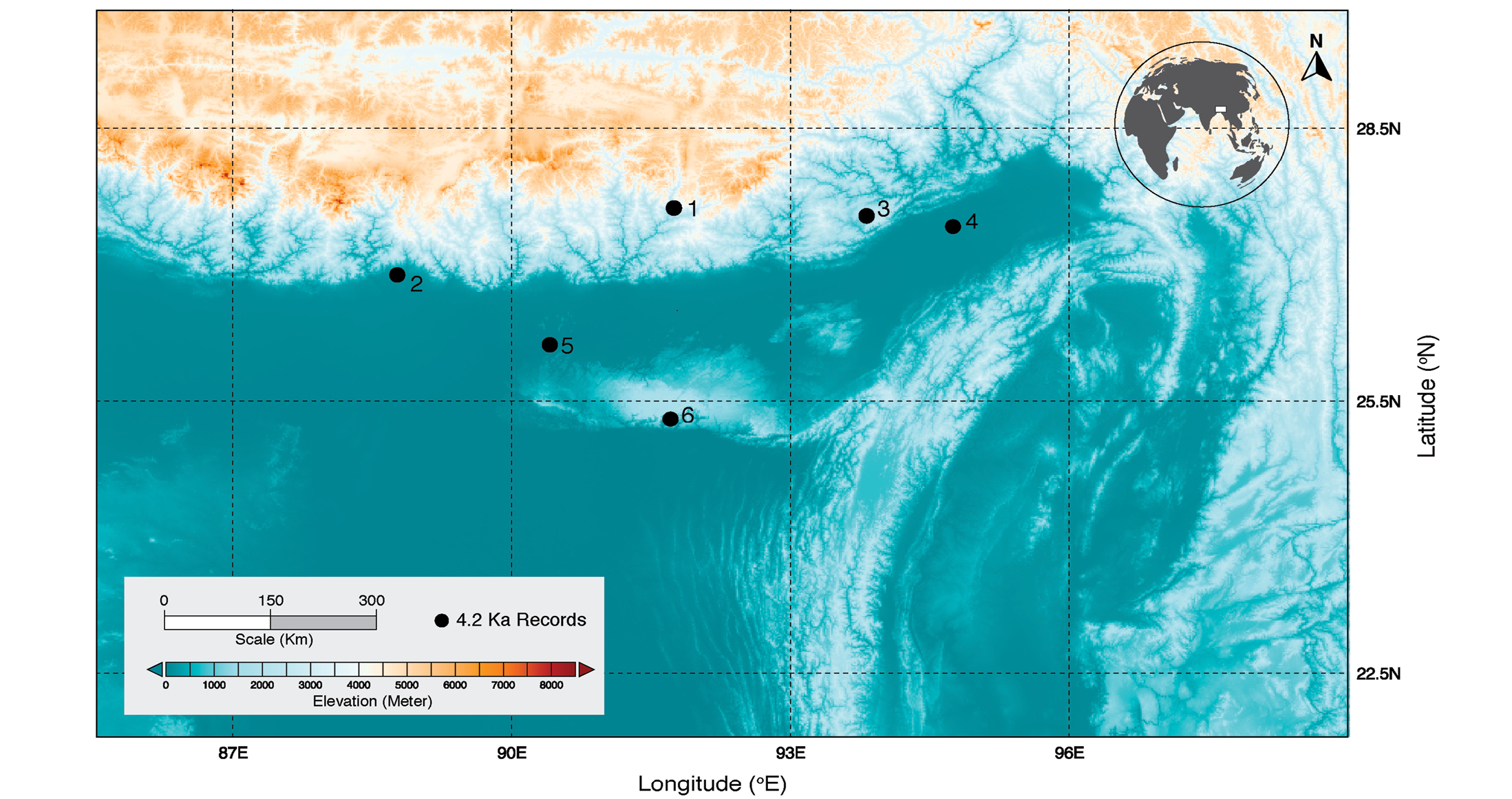- Home
- Publications
- PAGES Magazine
- Insight Into The 4.2 Ka Event Records In Northeast India: A Global Connection and The Geological Evidence
Insight into the 4.2 ka event records in northeast India: A global connection and the geological evidence
Nivedita Mehrotra and Santosh K. Shah
Past Global Changes Magazine
31(1)
28-29
2023
The local response of the environment to climate forcing in northeast India during the 4.2 ka event was coupled with human response to global changes in the natural environments. These sudden changes were coincidental to the decreased southwest monsoon strengths.
The 4.2 ka event
The response of the natural environment towards extreme climate events also has consequences for human societies. Abrupt climate change events, such as the 4.2 ka event, led to the global demise of several once-developed and flourishing human civilizations. In the eastern Himalayas, this was correlated with prolonged multi-decadal to multi-century droughts (Mehrotra et al. 2019).
There could have been natural forcing factors behind this sudden demise of populations observed in the Indus valley of ancient India, Egypt, and Mesopotamia around 4 kyr BP (Mehrotra et al. 2019). The forcing factors that led to this abrupt climate change event, coupled with human response, were sudden change in the monsoon pattern, fluctuation in solar radiation, and reduction in the sea-surface temperature (Berkelhammer et al. 2012; Bond et al. 2001; Dixit et al. 2014 and references therein; Hong et al. 2003; MacDonald 2011; Staubwasser et al. 2003).
Proxy records of paleoclimatic change during the 4.2 ka event have been studied at a global scale (Mehrotra et al. 2019). A few multi-proxy records in high-altitude settings in northeast India also record marked cold and dry conditions, such as at the Ziro and Pankang Teng Tso (PTTso) lakes in the eastern Himalayas (Ghosh et al. 2014; Mehrotra et al. 2019), or at Darjeeling Himalaya (mountain range in the foothills of the eastern Himalayas) (Gosh et al. 2015). In other locations, such as Lower Subansari and Assam, a reduction in monsoon strength was observed during the same period (Fig. 1) (Bera and Basumatary 2013; Tripathi et al. 2019).
Fluvial and lacustrine sediment records
The climate fluctuations during the mid-Holocene, and prevailing cold-dry conditions around 4.2 kyr BP, were observed in palynological, carbon isotope and paleomagnetic records from sediments at the catchment of PTTso Lake (Mehrotra et al. 2019) (Fig. 1: Site 1). The palynological and carbon isotope evidence from the sediments of the Neora and Murti river beds in the Jalpaiguri district of Darjeeling Himalaya (Fig. 1: Site 2) indicate a weak monsoon during ca. 4.3 to 3.5 kyr BP, impacting the regional plant community (Ghosh et al. 2015). The paleoclimatic interpretation of the pollen and carbon isotope records of Ziro lake record in Arunachal Pradesh, eastern Himalayas (Fig. 1: Site 3) was also similar (Ghosh et al. 2014).
The mean annual air temperature in this region of the eastern Himalaya increased, and the strength of the southwest monsoon has decreased since 3.8 kyr BP, thereby causing a reduction in forest cover (Ghosh et al. 2014). The study site at the lower Subansari region of Assam, in northeastern India, records a reduction in monsoon strength
(Fig. 1: Site 4). Paleovegetation reconstructions, based on palynological analysis of subsurface sediments from trenches of exposed fluvial deposits, suggest prevailing warm and dry conditions at around 4.3 kyr BP (Bera and Basumatary 2013).
Other pollen records from the Deepor wetlands of the western Bhramaputra flood plains in the tropical parts of Assam (Fig. 1: Site 5) also indicate less humid conditions, and a decline in southwest monsoon strength (Tripathi et al. 2019). This site records variations in forest cover, such as reduction of the Sal forests constituents (Shorea robusta and Terminalia sp.), along with the loss of marshy elements around 4.6 kyr BP, which was followed by a decline in tree taxa between 3.4 and 2.2 kyr BP (Tripathi et al. 2019).
While being cautious about potential chronological uncertainties between those studies, we can conclude that collective proxy evidence indicates that an arid phase began at around 4.2 kyr BP in the northeast part of India, which was characterized by a rise in air temperature, and weakening of the southwest monsoon. However, the manifestation of this trend in air temperature and precipitation was not accompanied by indications of human migrations, or any social impact in this region.
Speleothem records
The Cherrapunji region of Meghalaya in northeast India records one of the country's highest annual rainfalls, due to the seasonal influences of the monsoon. Speleothems from Mawmluh Cave in Meghalaya (Fig. 1: Site 6) are excellent archives of the monsoonal dynamics of the past. This site lends its name to the latest geological stage of the Quaternary, the Meghalayan Stage, which was formally ratified by the International Commission on Stratigraphy in June 2018 (Head 2019).
The lower boundary of the Meghalayan Stage begins at 4250 yrs before 2000 CE (Head 2019). The stalagmite retrieved from Mawmluh Cave (Fig. 2) is also the Global Boundary Stratotype Section and Point (GSSP). The δ18O data from this U/Th dated speleothem shows an abrupt climatic change at the 4.2 ka event, which has become a benchmark for the study of climate impact on human civilizations across Europe and Asia.
The 4.2 ka event forms the basis of the Meghalayan Stage/Age and the coincident subseries/subepoch of the Late/Upper Holocene (Walker et al. 2018). The Birbal Sahni Institute of Palaeosciences in Lucknow, India, conserves the type specimen of the Meghalyan Stage and the speleothem KM-A from Mawmluh Cave in Meghalaya (Fig. 2).
Holocene event and its cultural response to civilization
 |
|
Figure 2: Speleothem KM-A from the Mawmluh Cave, Meghalaya, the type specimen of the Meghalyan Stage and Upper Holocene subseries (image credit: Museum BSIP, Lucknow). |
Coupled human and environmental response of this so-called 4.2 ka abrupt climate change event are often observed in proxy records distributed globally. The northeast India region was subject to human migration towards eastern Asia during the Late Holocene (Tagore et al. 2022). This region is also known as a biodiversity hotspot, and a flora and fauna migration corridor to the subcontinent. In contrast to other regions in which there are archaeological studies available in different parts of the Middle East (Mehrotra et al. 2019), in northeast India there is a distinct lack of archaeological evidence that prevents the study of human response to the 4.2 ka event in this region, and to link it to a global civilization collapse event. Nevertheless, the recognition of the Mawmluh Cave site as a geological heritage site by the International Union of Geological Sciences, due to its key relevance for the understanding of the impact of climate change on human civilizations, proves the significance of northeast India as a recorder of the 4.2 ka event. The preservation of abrupt climatic change event signals is evident in other paleoclimatic records from northeast India (Mehrotra et al. 2019), including isotopic, palynological and sedimentological proxies. Additional and more exhaustive work is needed to find supportive evidence of human-induced changes, or coupled societal implications, during the 4.2 ka event in this region.
affiliation
Birbal Sahni Institute of Palaeosciences, Lucknow, India
contact
Nivedita Mehrotra: nivedita_mehrotra bsip.res.in
bsip.res.in
references
Bera SK, Basumatary SK (2013) Journal of Paleosciences 62: 1-10
Bond GC et al. (2001) Science 294: 2130-2136
Dixit Y et al. (2014) Geology 42(4): 339-342
Ghosh R et al. (2014) Quat Int 325: 13-29
Ghosh R et al. (2015) Quat Sci Rev 114: 100-115
Head MJ (2019) Quat Int 500: 32-51
Hong YT et al. (2003) Earth Plan Sci Lett 211(3-4): 371-380
MacDonald G (2011) Quat Int 229: 140-148
Mehrotra N et al. (2019) Quat Int 507: 206-216
Staubwasser M et al. (2003) Geophys Res Lett 30: 1425
Tagore D et al. (2022) Front Genet 13: 1023870
